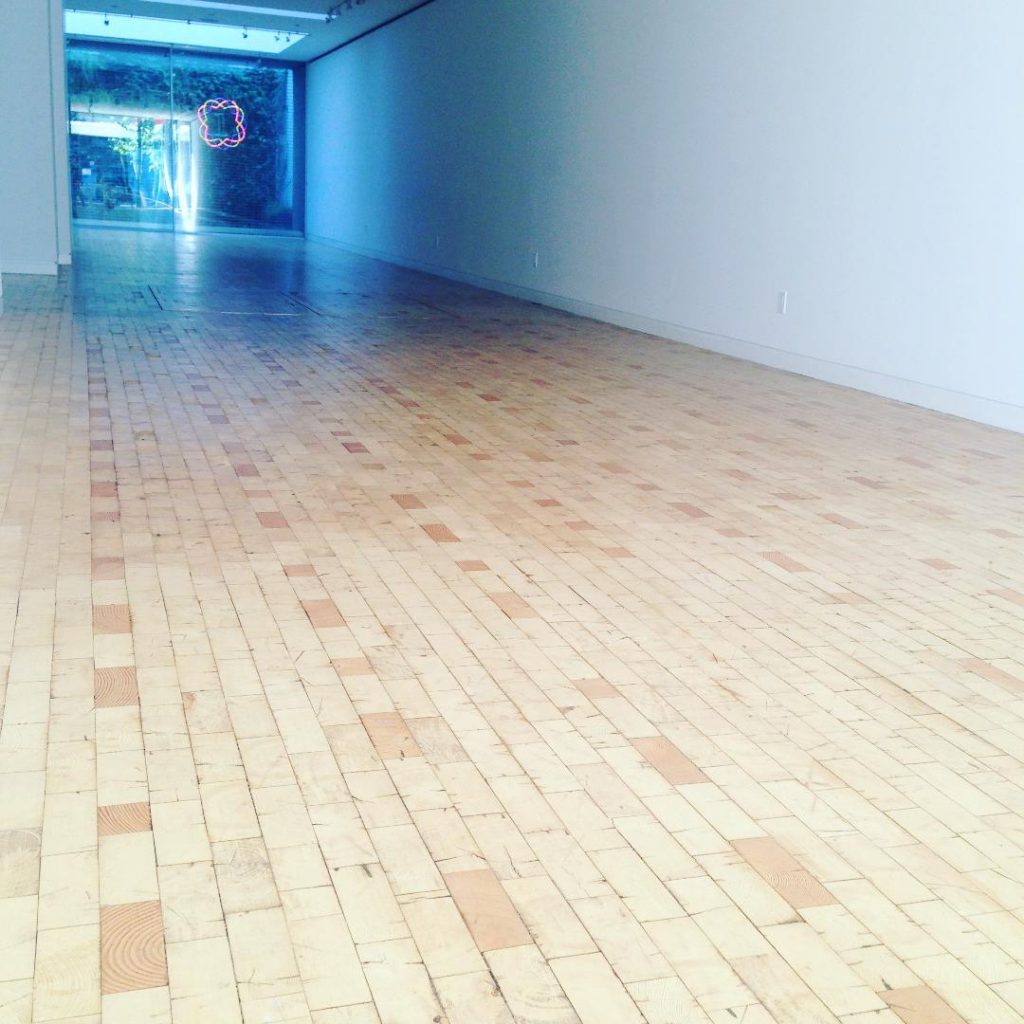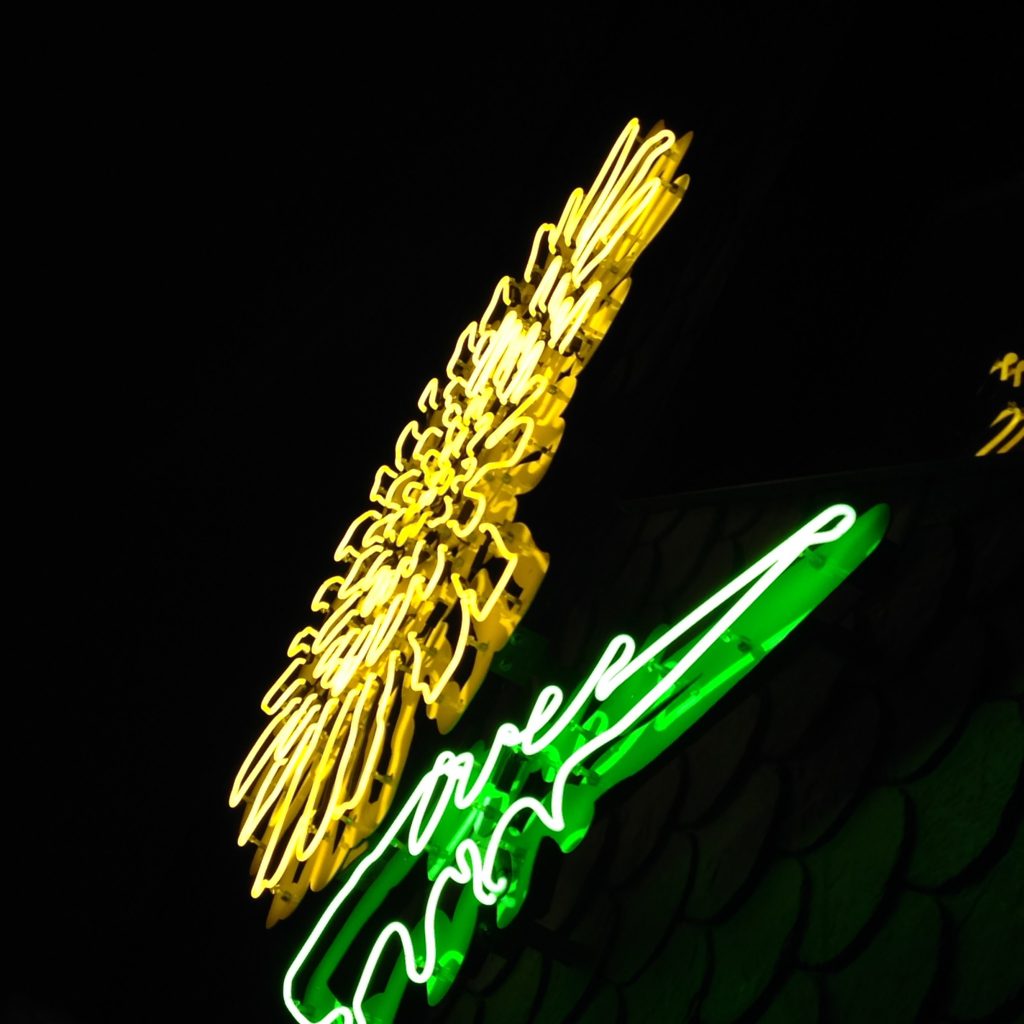
The darker blocks within the wood floor of happylucky no. 1, an art gallery and community arts space in the Crown Heights section of Brooklyn, spell out the name of the place in morse code, according to Liane Fredel.
Fredel, the former graphic designer who bought the space five years ago, renovated it to express, “an inviting concept, open but with an air of mystery,” she said, and she intends it to foster “more than just art, but rather a larger sense of culture.”
There is no sign outside announcing the place. There is, however a website, that offers this by way of description:
…a gray, fishscaly building…. The façade is marked by a door and a yellow neon dandelion. We are not exactly sure what happens, or what will happen, within the elongated rectangular box that is the interior of happylucky no. 1. Vaguely speaking, there will be events, exhibitions and experiments, the subjects/results of which might occasionally be edible, or medicinal.
There will be things on the walls and floors and floating through the air; sights, sounds and ideas requesting your assistance in their propagation. There will be triumphs and, as this is a human endeavor, the occasional disaster.
All of the above—the subtly encoded messages, the overarching mission and the blend of seriousness and humor—make happylucky no. 1 a fitting home for the latest iteration of The Stone— which began as a tiny but influential East Village performance space in an unmarked windowless former Chinese restaurant, founded by John Zorn in 2005 to present experimental music, and that has grown into a somewhat sprawling initiative.
Zorn, whose influence as a producer and presenter now equals his stature as a musician and composer, has curated “The Stone Series” at happylucky no. 1, beginning March 1—Friday and Saturday night performance that will run at least through 2020.

I wrote in the Village Voice about the 2018 closing of Zorn’s East Village club, and the establishment of The Stone within the New School’s College of Performing Arts, taking up residence in the New School’s Glass Box Theater, a sleek climate-controlled space featuring a glass wall facing a busy Greenwich Village street. Weekly shows, Tuesdays through Saturdays, continue at this flagship location. These days, there are also a Stone Commission Series at National Sawdust, a high-culture outpost in the Williamsburg section of Brooklyn, and a monthly Stone series at Russ and Daughters, a Lower East Side landmark best known for its bagels, bialys and smoked fish.
Throughout his career, Zorn has been branded many things and might once have been cast as an avant-garde outsider. Yet times—though not so much, Zorn—have changed. His music has been celebrated at Manhattan cultural temples including Lincoln Center, the Metropolitan Museum of Art and the Village Vanguard, not to mention festivals of all stripes worldwide; his aesthetic and his ever-widening circle of collaborators now fuels and helps shape whatever we mean by the forward-moving, genre-defying construct “creative music.” Zorn is, simply put, creative music’s consummate “doer.” He gets an awful lot accomplished, much of it in exalted fashion. That there is no easy summing up of Zorn’s artistry has something to do with his refusal to heed aesthetic boundaries, yes, but it’s also just a function of how much work there is, and how consistently and exponentially it all evolves.
For all the seeming complexity of his artistry, Zorn’s approach to collaboration is simple. “I find people I want to work with,” he once told me, “and we just get down to it.” I recall interviewing Zorn and director Richard Foreman for The Wall Street Journal about their 2009 collaboration, “Astronome: A Night at the Opera.” As Foreman explained to me: “I ran in to John on a street corner. I told him, ‘Why don’t you write me an opera?’ He shrugged and said ‘OK.’ So we did.”
In December last year, after a mutual acquaintance introduced Zorn to Fredel, he stopped by her Brooklyn gallery. “He came in,” said Fredel, “and he was like a firecracker—boom, boom, boom—here’s what you need to do.” Other than some sound-absorbing curtains and dedicated green room, the gallery needed little alteration. Within 48 hours of their meeting, Zorn sent a full schedule of bookings through 2020. (“I had a free weekend,” Zorn explained.)
Fredel’s space is run by her, independently. For The Stone Series, she will adhere to Zorn’s rules: musicians earn 100% of the door (admission is $20); no food or drink will be served; and no photography, video or recording by audience members will be allowed. The Opening weekend (March 1 & 2) will present all-star “Improv Nights,” featuring Zorn, among others. (A complete schedule can be found here.)
When Fredel and I met earlier this month, we sat on the folding chairs upon wooden risers that form her movable concert hall, and that houses a capacity roughly the same as the original Stone room (72). The cushions that form the audience’s first row reminded me of those at Preservation Hall, in New Orleans, which also originated as a music series at an art gallery.
Fredel said that her gallery’s odd name was meant simply to indicate “something that is positive and good.” But it sounds like a New York Chinese take-out joint. That harks back, coincidentally, to The Stone’s origins, in a former Chinese place. And, for Fredel, there’s a deeper resonance.
“We’re a takeout too,” she said, “just a different kind of takeout. You take joy out of this place.”
